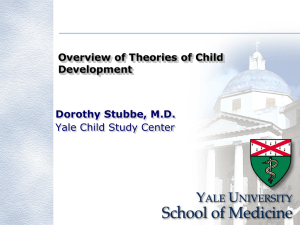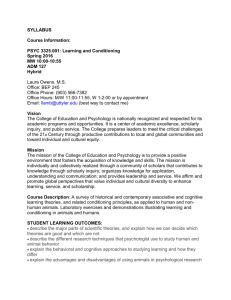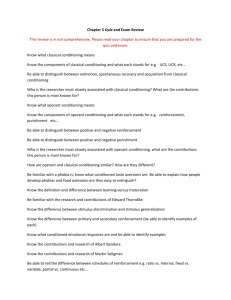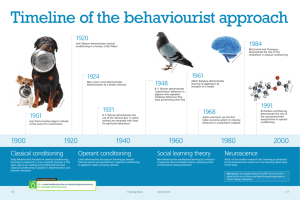SYLLABUS Course Information: PSYC 3325.001: Learning and
advertisement
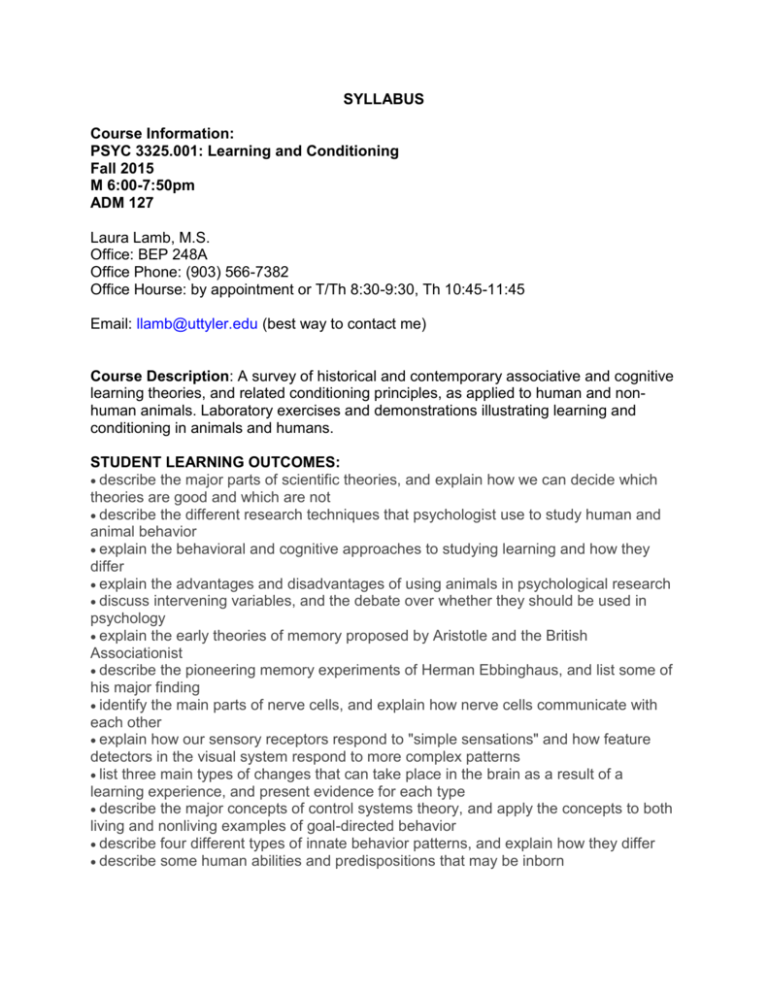
SYLLABUS Course Information: PSYC 3325.001: Learning and Conditioning Fall 2015 M 6:00-7:50pm ADM 127 Laura Lamb, M.S. Office: BEP 248A Office Phone: (903) 566-7382 Office Hourse: by appointment or T/Th 8:30-9:30, Th 10:45-11:45 Email: llamb@uttyler.edu (best way to contact me) Course Description: A survey of historical and contemporary associative and cognitive learning theories, and related conditioning principles, as applied to human and nonhuman animals. Laboratory exercises and demonstrations illustrating learning and conditioning in animals and humans. STUDENT LEARNING OUTCOMES: describe the major parts of scientific theories, and explain how we can decide which theories are good and which are not describe the different research techniques that psychologist use to study human and animal behavior explain the behavioral and cognitive approaches to studying learning and how they differ explain the advantages and disadvantages of using animals in psychological research discuss intervening variables, and the debate over whether they should be used in psychology explain the early theories of memory proposed by Aristotle and the British Associationist describe the pioneering memory experiments of Herman Ebbinghaus, and list some of his major finding identify the main parts of nerve cells, and explain how nerve cells communicate with each other explain how our sensory receptors respond to "simple sensations" and how feature detectors in the visual system respond to more complex patterns list three main types of changes that can take place in the brain as a result of a learning experience, and present evidence for each type describe the major concepts of control systems theory, and apply the concepts to both living and nonliving examples of goal-directed behavior describe four different types of innate behavior patterns, and explain how they differ describe some human abilities and predispositions that may be inborn define habituation, and list the general principles of habituation that are found in all animal species discuss what is known about the physiological mechanisms of habituation describe opponent-process theory, and diagram the typical pattern of an emotional response to a new stimulus and to a stimulus that has been repeated many times describe the procedure of classical conditioning and some of the most common ways it is studied in the laboratory explain Pavlov's stimulus substitution theory, and describe its strengths and weaknesses describe the basic principles of classical conditioning, including acquisition, extinction, spontaneous recovery, conditioned inhibition, generalization, and discrimination explain how the timing of the stimuli in a classical conditioning procedure affects the results give examples of classical conditioning that are found in everyday life describe some of the main behavior therapies that are based on classical conditioning explain the blocking effect and why it is important describe the basic concepts of the Rescorla-Wagner model and how it accounts for conditioning phenomena such as acquisition, extinction, blocking, and conditioned inhibition describe the different types of associations that can form during classical conditioning explain how heredity can influence what animals and people learn through classical conditioning discuss the role that classical conditioning plays in drug tolerance and addiction describe Thorndike's Law of Effect and experiments on animals in the puzzle box discuss how the principle of reinforcement can account for superstitious behaviors describe the procedure of shaping and explain how it can be used in behavior modification explain B.F. Skinner's free operant procedure, three-term contingency, and the basic principles of operant conditioning define instinctive drift, and explain why some psychologist believed that it posed problems for the principle of reinforcement define autoshaping and discuss different theories about why it occurs identify different procedures for increasing or decreasing behavior discuss the phenomenon of learned helplessness as it occurs in animals and people describe factors that determine whether punishment will be effective explain the disadvantages of using punishment as a method of controlling behavior describe different types of behavior decelerators and how they are used in behavior therapy identify different procedures for increasing or decreasing behavior describe 3 theories of avoidance and explain their strengths and weaknesses therapy define errorless discrimination learning and give examples of its use in behavior modification describe some ways that stimulus control techniques are used in behavior modification explain what is known about observational learning by animals explain Bandura's theory about the four factors necessary for successful imitation give examples of how observational learning and operant conditioning can interact to determine an individual's behavior give some specific examples of the variety of behaviors that can be learned through observation describe several ways in which modeling has been used in behavior therapy discuss whether performing a response and receiving a reinforcer are essential in the learning and in the performance of the new behavior describe studies on how reinforcement can be used to control visceral responses, and explain how these techniques have been used in biofeedback list 5 different theories about how we can predict what will serve as a reinforcer, and discuss the strengths and weaknesses of the different theories explain how a functional analysis of reinforcers can be used to determine the causes of unusual or puzzling behaviors give examples of how the field of behavioral economics has been applied to animal and human behavior describe how short-term memory and rehearsal have been studied with animals describe how long-term memory has been studied with animals explain what is known about animals’ abilities to measure time, to count, and to learn serial patterns discuss different attempts to teach language to animals and evaluate their success describe research on animals’ abilities in the areas of object permanence, analogies, and metacognition EVALUATION AND GRADING: Chapter Quizzes Average: 35% of grade Project Based Learning Assignment Average: 35% of final grade Attendance Average: 10% of final grade Midterm Exam: 10% of final grade (10/21/15) Final Exam: 10% of final grade (12/7/15) Please do not contact me asking me to round your grade or tell you what your average it. You can calculate that by doing simple mathematics. Textbooks: Mazur, James E. (2013). Learning and Behavior,7ed. ISBN: 0-13-193163-6 When are the quizzes? The quizzes will be administered online . You can take your quiz wherever you have reliable internet access. I will announce in class (super important that you attend) 1 week prior to the quiz being deployed. Module 1: Introduction material Module 2: Ch. 1 Module 3: Ch. 2 PBL Introduction Assignment Module 4: Ch. 3 Module 5: Classical Conditioning exercises Ch. 4 Module 6: Ch. 5 Shaping PBL assignment: Module 7: Ch. 6 Schedules of Reinforcement PBL Token Economy/Behavioral Contracting PBL: Module 8: Ch. 7 5 Behavior Decelerators PBL Module 9: Ch. 8 Module 10: Ch. 9 Module 11: Ch. 10 Module 12: Ch. 11 PROJECT BASED LEARNING ASSIGNMENT During this semester, you will have a BIG project based learning (PBL) assignment. It is a project that we will begin at the beginning of the semester and then continue till the end. It is a progressive project and we will continually be adding to it. The wonderful thing about this assignment is that it is not MAJOR based. Regardless of what major you are, you will truly learn and benefit from this assignments. The product that you submit is unique to each of you. Not a single project will be the same. You MUST submit this assignment via Blackboard. I will NOT take email submissions under any circumstance (except for documented reasons---see below). Please do not ask. I will announce in class the due date for each assignment. I will give the announcement two weeks prior to the due date. You may always work ahead if you wish. Please make sure you are attending class so you won’t miss out on these announcements. There are 6 parts to the assignment: 1. Introduction- “The Foundation” (15 points) 2. Shaping (15 points) 3. 4 Schedules of Reinforcement (20 points) 4. Token Economy/Behavior Contracting (10 points) 5. 5 Behavior Decelerators (25 points) 6. Final Presentation (15 points) The Presentation will be set up as a “PBL Online Fair” and open to all students in the class. It will be done through Blackboard. Each assignment will be converted to a percentage. There are video links under the respective module assignment explaining each assignment. Please be sure to watch the video to obtain the instructions for the assignment. There is a grading rubric located under course documents. Great attention should be paid to the grading rubrics before beginning each assignment. ATTENDANCE: Attendance counts for 10% of your final grade. Each class period, I will call role. I will call role at any point during the time our class is meeting. If you are not present when your name is called, you will not get your points for the day. If you are more than 5 minutes tardy to class, you will be counted absent. If you leave class early at any time, please do not expect to be counted for attendance that day. It is an all or nothing thing. If you have a doctor’s documented illness, university related absence (e.g. athlete), death of a close relative, please see me. University representatives and athletes have a protocol for missing class. WHERE ARE THE LECTURES? I will lecture in class over the chapter content. However, I have also provided you with some more tools. I have compiled a plethora of lecture content under each module. Some of the content is me doing “mini-lectures”, others are video clips and material I have collected for your review. You cannot expect to do well in this class if you only read through the material once and then take your quiz. You are also expected to have done all required reading and video viewing before the required class meetings. I recommend printing out the skeleton Powerpoints, reading the chapters while beefing up the PP, and then review your notes. Of course you also need to watch and review the lecture and content videos. DISCUSSION BOARD- CONTENT Q&A’s You will find a link under each Module called “DO YOU HAVE CONTENT QUETSIONS”? If you have a question about content in that module, please click on that link and it will take you to a DB forum. First, you should check to see if someone else has asked the question, if not, please post your question and I will post a reply answer for everyone to see. This will create a library of Q&A’s for this course. You have the option to make your post anonymous. Please choose this option if it would make you more comfortable. Hopefully this will encourage more of you to post content questions Sample Content Q&A’s: 1. Can you tell me the difference b/w the unconditioned stimulus and the conditioned stimulus? 2. What is the difference b/w operant and classical conditioning? 3. I am confused about extinction. I thought it meant XXXXXX. Can you clarify? Questions that are NOT to be put on the Content Q&A: 1. Anything that relates to the working of the class (e.g. when assignments are due, how to finish an assignment, etc.). You should email those questions directly to me. 2. Questions you are posing to other students. Please do that through email. 3. Anything that is not CONTENT (meaning from you book) related. LATE WORK: I do NOT accept late work. . I also do not accept any assignments via email. All assignments are submitted through Blackboard. Please respect this policy. UNIVERSITY POLICIES: Students Rights and Responsibilities To know and understand the policies that affect your rights and responsibilities as a student at UT Tyler, please follow this link: http://www2.uttyler.edu/wellness/rightsresponsibilities.php Grade Replacement/Forgiveness and Census Date Policies Students repeating a course for grade forgiveness (grade replacement) must file a Grade Replacement Contract with the Enrollment Services Center (ADM 230) on or before the Census Date of the semester in which the course will be repeated. Grade Replacement Contracts are available in the Enrollment Services Center or at http://www.uttyler.edu/registrar. Each semester’s Census Date can be found on the Contract itself, on the Academic Calendar, or in the information pamphlets published each semester by the Office of the Registrar. Failure to file a Grade Replacement Contract will result in both the original and repeated grade being used to calculate your overall grade point average. Undergraduates are eligible to exercise grade replacement for only three course repeats during their career at UT Tyler; graduates are eligible for two grade replacements. Full policy details are printed on each Grade Replacement Contract. The Census Date is the deadline for many forms and enrollment actions that students need to be aware of. These include: withhold directory information, approvals for taking courses as Audit, Pass/Fail or Credit/No Credit. after the Census Date) a “W” grade) -enrolled in classes after being dropped for non-payment through Financial Aid. State-Mandated Course Drop Policy Texas law prohibits a student who began college for the first time in Fall 2007 or thereafter from dropping more than six courses during their entire undergraduate career. This includes courses dropped at another 2-year or 4-year Texas public college or university. For purposes of this rule, a dropped course is any course that is dropped after the census date (See Academic Calendar for the specific date). Exceptions to the 6-drop rule may be found in the catalog. Petitions for exemptions must be submitted to the Enrollment Services Center and must be accompanied by documentation of the extenuating circumstance. Please contact the Enrollment Services Center if you have any questions. Disability Services In accordance with Section 504 of the Rehabilitation Act, Americans with Disabilities Act (ADA) and the ADA Amendments Act (ADAAA) the University offers accommodations to students with learning, physical and/or psychiatric disabilities. If you have a disability, including non-visible disabilities such as chronic diseases, learning disabilities, head injury, PTSD or ADHD, or you have a history of modifications or accommodations in a previous educational environment you are encouraged to contact the Student Accessibility and Resources office and schedule an interview with the Accessibility Case Manager/ADA Coordinator, Cynthia Lowery Staples. If you are unsure if the above criteria applies to you, but have questions or concerns please contact the SAR office. For more information or to set up an appointment please visit the SAR office located in the University Center, Room 3150 or call 903.566.7079. You may also send an email to cstaples@uttyler.edu Student Absence due to Religious Observance Students who anticipate being absent from class due to a religious observance are requested to inform the instructor of such absences by the second class meeting of the semester. Student Absence for University-Sponsored Events and Activities If you intend to be absent for a university-sponsored event or activity, you (or theevent sponsor) must notify the instructor at least two weeks prior to the date of the planned absence. At that time the instructor will set a date and time when make-up assignments will be completed. Social Security and FERPA Statement: It is the policy of The University of Texas at Tyler to protect the confidential nature of social security numbers. The University has changed its computer programming so that all students have an identification number. The electronic transmission of grades (e.g., via e-mail) risks violation of the Family Educational Rights and Privacy Act; grades will not be transmitted electronically. Emergency Exits and Evacuation: Everyone is required to exit the building when a fire alarm goes off. Follow your instructor’s directions regarding the appropriate exit. If you require assistance during an evacuation, inform your instructor in the first week of class. Do not reenter the building unless given permission by University Police, Fire department, or Fire Prevention Services. Student Standards of Academic Conduct Disciplinary proceedings may be initiated against any student who engages in scholastic dishonesty, including, but not limited to, cheating, plagiarism, collusion, the submission for credit of any work or materials that are attributable in whole or in part to another person, taking an examination for another person, any act designed to give unfair advantage to a student or the attempt to commit such acts. (i) “Cheating” includes, but is not limited to: • copying from another student’s test paper; • using during a test, materials not authorized by the person giving the test; •failure to comply with instructions given by the person administering the test; •possession during a test of materials which are not authorized by the person giving the test, such as class notes or specifically designed “crib notes”. The presence of textbooks constitutes a violation if they have been specifically prohibited by the person administering the test; • using, buying, stealing, transporting, or soliciting in whole or part the contents of an unadministered test, test key, homework solution, or computer program; • collaborating with or seeking aid from another student during a test or other assignment without authority; • discussing the contents of an examination with another student who will take the examination; • divulging the contents of an examination, for the purpose of preserving questions for use by another, when the instructor has designated that the examination is not to be removed from the examination room or not to be returned or to be kept by the student; • substituting for another person, or permitting another person to substitute for oneself to take a course, a test, or any course-related assignment; • paying or offering money or other valuable thing to, or coercing another person to obtain an unadministered test, test key, homework solution, or computer program, or information about an unadministered test, test key, homework solution or computer program; • falsifying research data, laboratory reports, and/or other academic work offered for credit; • taking, keeping, misplacing, or damaging the property of U. T. Tyler, or of another, if the student knows or reasonably should know that an unfair academic advantage would be gained by such conduct; and, • misrepresenting facts, including providing false grades or resumes, for the purposeof obtaining an academic or financial benefit or injuring another student academically or financially. (ii) “Plagiarism” includes, but is not limited to, the appropriation, buying, receiving as a gift, or obtaining by any means another’s work and the submission of it as one’s own academic work offered for credit. (iii) “Collusion” includes, but is not limited to, the unauthorized collaboration with another person in preparing academic assignments offered for credit or collaboration with another person to commit a violation of any section of the rules on scholastic dishonesty. Vision The College of Education and Psychology is nationally recognized and respected for its academic programs and opportunities. It is a center of academic excellence, scholarly inquiry, and public service. The College prepares leaders to meet the critical challenges of the 21st Century through productive contributions to local and global communities and toward individual and cultural equity. Mission The mission of the College of Education and Psychology is to provide a positive environment that fosters the acquisition of knowledge and skills. The mission is individually and collectively realized through a community of scholars that contributes to knowledge through scholarly inquiry; organizes knowledge for application, understanding and communication; and provides leadership and service. We affirm and promote global perspectives that value individual and cultural diversity to enhance learning, service, and scholarship.


